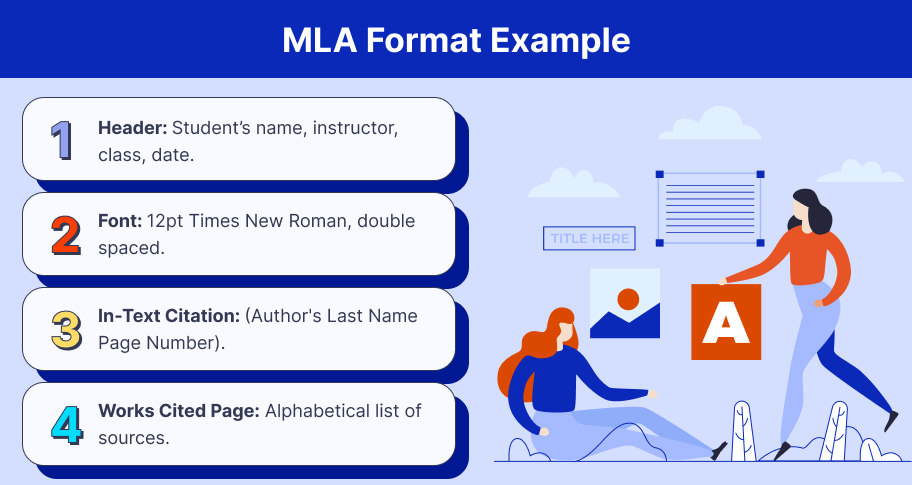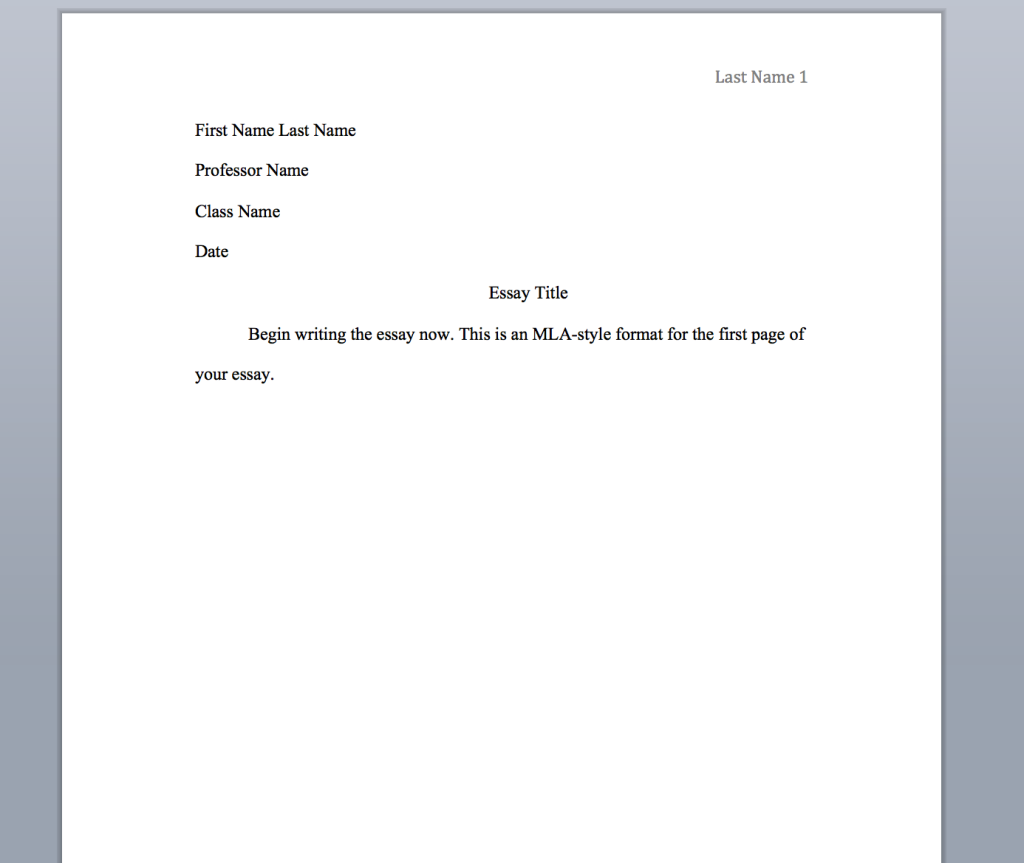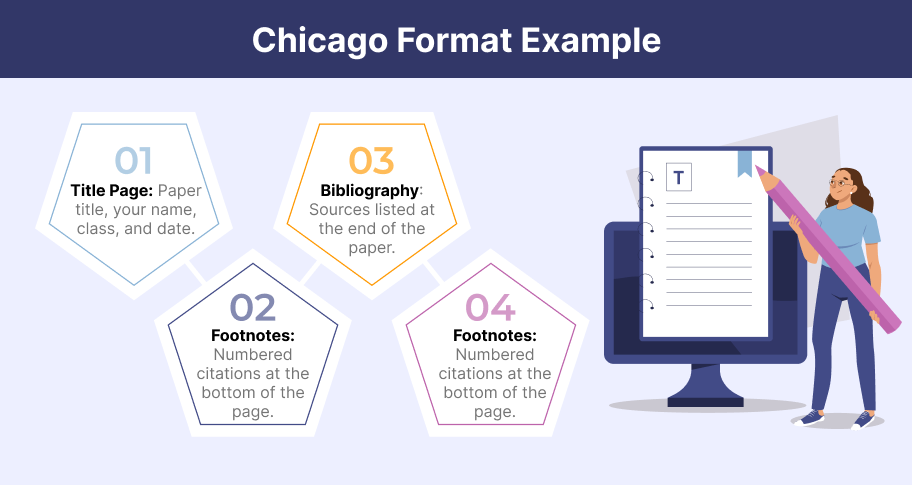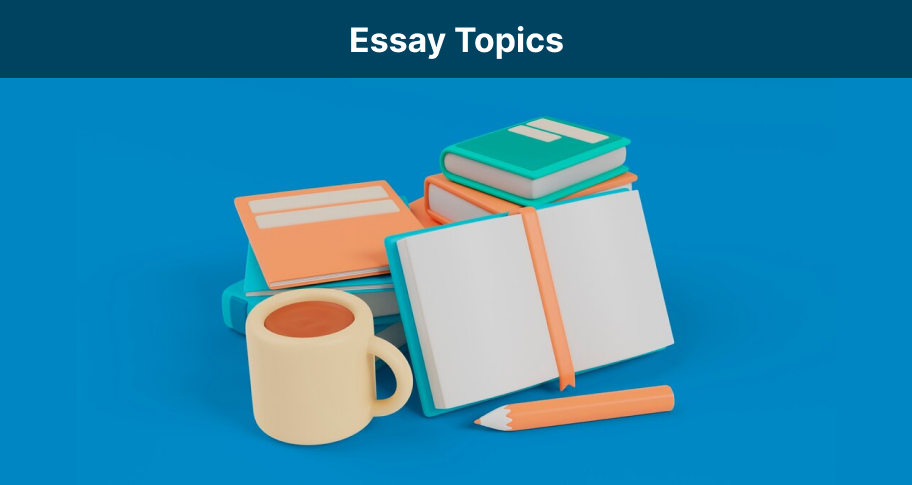Introduction
Content is king, but mastering the mechanics of academic writing is equally important. That’s why formatting your essay matters. Proper formatting allows you to present your essays and term papers clearly, logically, and academically so that it is easy for readers to follow your argument and for instructors to assess your work. Poor formatting, on the other hand, can lead to point deductions, even if the content of your essay is strong.
What is Proper Essay Format?
The format of an essay refers to its basic structure, layout, and appearance on the page. It includes elements such as margins, font size, line spacing, and citation style, among others. Although it may seem daunting at first, mastering the different essay formats is not as difficult as it might appear. The more essays you write, the more familiar you will become with these formats. (Check out this article for more info on how to write an essay).
Importance of Following Proper Format
Understanding and applying the correct essay format is essential for several reasons. First, it demonstrates your attention to detail and your ability to follow academic conventions. Proper formatting also improves the readability of your essay, allowing your ideas to be presented in a clear and organized manner. Proper formatting is what lets you meet the academic standards expected in your field of study.
Overview of Main Formats
There are several widely recognized essay formats, each commonly used in different academic disciplines. The Modern Language Association (MLA) format is often used in the humanities, particularly in literature and language studies. The American Psychological Association (APA) format is typically used in the social sciences, such as psychology and education. The Chicago Manual of Style, or Chicago format, is frequently used in history and some social science fields. Each format has its own set of rules for citations, references, and overall layout.
View 120,000+ High Quality Essay Examples
Learn-by-example to improve your academic writing
Standard College Essay Format
There is no universally “right” college essay format, be we do have some commonly accepted guidelines. Professors may have specific preferences, so understanding the standard structure and formatting rules will help you adapt to any requirements.
Basic Components of Any Essay
- Title Page: This usually includes the title of your essay, your name, the course name, the instructor’s name, and the date of submission. The title should be centered and written in a standard font, without italics or underlining.
- Introduction: The introduction is the opening paragraph of your essay, where you present the topic and your thesis statement. It should contain a hook, a brief overview of the main points that will be discussed in the body of the essay, and your main point.
- Body: The body of the essay is where you develop your arguments or analysis in detail. Each paragraph of the body should focus on a specific point or piece of evidence that supports your thesis.
- Conclusion: The conclusion is the final paragraph of your essay, where you summarize the main points and restate your thesis in light of the evidence presented. It should contain no new info, but should leave lasting impression on the reader so as to reinforce the significance of your essay.
- Bibliography: Also known as the Works Cited or References page, the bibliography lists all the sources you cited in your essay. The format of the bibliography varies depending on the citation style (MLA, APA, Chicago, etc.), but it typically includes the author’s name, title of the work, publication information, and date.
General Formatting Rules
- Fonts: Standard college essays typically use a uniform font for consistency and readability. Times New Roman is the most widely accepted font, though Arial is sometimes permitted. The font size is usually set to 12 points. Font should be consistent across the entire document.
- Line Spacing: Most college essays require double spacing. Occasionally, you may be asked to use single spacing or 1.5 spacing, depending on the instructor’s preference or the specific assignment guidelines.
- Margins: The standard margin size for college essays is one inch on all sides (top, bottom, left, and right). This margin size is typically the default setting in Word.
- Page Numbers: Including page numbers in your essay is generally expected, especially for longer assignments. Page numbers are usually placed in the upper right corner of each page, sometimes accompanied by your last name or the title of the essay.
- Title Page: Short essays often do not require a title page, but for longer essays or research papers, a title page will probably be mandatory. If required, the title page should follow the specific format outlined by your instructor (APA, MLA, etc.), typically including the title of the essay, your name, course details, and submission date.
MLA Essay Format
MLA Structure and Layout
MLA format is known for its simplicity. The following are the basic components of an essay written in MLA format:
- 12-Point Font (Times New Roman): Times New Roman in 12-point font is the standard typeface used in MLA format.
- First Line Indent: Each paragraph in an MLA-formatted essay begins with an indentation of the first line, typically set at half an inch from the left margin. This indentation visually separates paragraphs, which makes the essay easy to read.
- Double-Spacing: The entire essay should be double-spaced, including the text, block quotes, and the Works Cited page. Double spacing should be consistent throughout. It is especially helpful as it allows space for instructors to make annotations.
- 1-Inch Margins: MLA format requires uniform 1-inch margins on all sides of the page (top, bottom, left, and right), which keeps the page balanced in appearance.
- Header: Unlike APA format, MLA does not usually require a title page. Instead, your name, your professor’s name, the course name, and the date should be listed in the upper left-hand corner of the first page. Below this information, the title of the essay should be centered and written in standard title case (capitalizing the first and main words of the title). A header with your last name and page number should appear in the upper right corner of each page, beginning with the first page.
MLA In-Text Citations and Works Cited
MLA format has specific guidelines for citing sources both within the text and in the Works Cited page. These citations are crucial for giving credit to the original authors and for allowing readers to trace the sources of your information.
- In-Text Citations: In MLA format, in-text citations are brief and are usually placed at the end of the sentence before the period. They include the author’s last name and the page number where the information was found, all within parentheses. For example: (Smith 123). If the author’s name is mentioned in the sentence, only the page number is required in the citation: (123). Even when paraphrasing or summarizing, the page number must be included, which can be a challenge but is essential to meet MLA standards.
- Works Cited Page: The Works Cited page appears at the end of the essay and lists all the sources referenced in your paper. Each entry should be formatted with a hanging indent, where the first line of the citation is flush with the left margin, and subsequent lines are indented. Entries are listed alphabetically by the author’s last name or by the title if no author is provided. The general format for a book citation in MLA is: Author’s Last Name, First Name. Title of Book. Publisher, Year of Publication.

MLA Common Mistakes to Avoid
While MLA format is straightforward, there are common mistakes that students often make:
- Incorrect In-Text Citations: Failing to include the page number, using the wrong format for the author’s name, or placing the period outside the parentheses are frequent errors. Always double-check your in-text citations for accuracy.
- Improper Works Cited Formatting: Not following the correct order, incorrect use of italics or quotation marks, and missing publication details are common pitfalls. Ensure each entry adheres to MLA guidelines.
- Missing or Incorrect Header: Forgetting to include the header with your last name and page number on each page can lead to a lower grade. Also, ensure that the header is properly aligned with the right margin.
Example of MLA Format
Here’s a simplified example of how the first page of an MLA-formatted essay might look:
First Page of an MLA Paper:

APA Essay Format
APA Structure and Layout
APA format follows a set structure that includes a title page, abstract, body, and references.
- Title Page: The title page in APA format is crucial as it sets the tone for your paper. It includes the title of your essay, your name, and your institutional affiliation, all centered on the page. The title should be concise and informative, reflecting the content of your paper. Below the title, your name appears, followed by your institution (e.g., university name). Some instructors may ask for additional information like the course title, instructor’s name, and the date.
- Abstract: The abstract is a brief summary of your paper, usually between 150-250 words. It gives a summary of your research, including the research question, methods, results, and conclusions. The abstract appears on its own page, right after the title page, and is typically a single paragraph without indentation. Abstracts are used in longer research papers and dissertations to give readers a quick snapshot of the study’s content and findings.
- Body: The body of an APA paper is where you present your argument or findings. It starts on a new page after the abstract and is divided into sections such as the introduction, method, results, discussion, and conclusion, depending on the type of paper you are writing. Each section may include subheadings to improve organization and readability.
- References: The reference page, which comes at the end of your paper, lists all the sources cited in the text. This page follows specific APA formatting rules, including the use of a hanging indent and alphabetical order by the authors’ last names. The reference entries must include detailed information about each source, such as the author’s name, publication year, title of the work, and source.

APA In-Text Citations and References
APA style uses the author-date citation method, which includes the author’s last name and the publication year in the text. This method allows readers to locate the full citation in the reference list easily.
- In-Text Citations: In-text citations in APA format are concise. For example, if you’re citing a book by John Doe published in 2020, the citation would appear as (Marve, 2024). If you directly quote a source, you must also include the page number: (Smith & Wesson, 2023, p. 15). These citations are usually placed at the end of a sentence before the period.
- References: Every in-text citation must correspond to an entry in the reference list. The reference list provides full details about the source, formatted in a specific way. For a book, the format is: Author’s Last Name, First Initial(s). (Year). Title of the book. Publisher.
APA Headings and Subheadings
Headings and subheadings are essential in APA format as they help organize the content and guide readers through the paper. APA uses a specific hierarchy of headings:
- Level 1 Heading: Centered, Bold, Title Case (e.g., Introduction)
- Level 2 Heading: Flush Left, Bold, Title Case (e.g., Review of Literature)
- Level 3 Heading: Indented, Bold, Sentence case, ending with a period. (e.g., Methods)
Subheadings break down sections into more detailed parts, making your essay easier to follow.
Example of APA Format

Chicago Essay Format
Overview of Chicago Style
Chicago style follows a standard set of formatting guidelines, which include:
- 12-Point Font (Times New Roman): Chicago style typically uses Times New Roman in 12-point font, which is considered a classic and highly readable typeface.
- First Line Indent: Each paragraph should begin with a half-inch indent, creating a clear separation between sections of text.
- Double-Spacing: The entire document, including block quotes, notes, and bibliography, should be double-spaced, providing ample room for comments or corrections.
- 1-Inch Margins: Chicago style requires 1-inch margins on all sides of the page, which is standard for most academic papers.
Chicago style is known for its flexibility, especially in the way it handles citations. Unlike MLA or APA formats, which rely on in-text parenthetical citations, Chicago style allows for the use of either footnotes or endnotes, which are a less obtrusive way to cite sources.
Chicago Footnotes vs. Endnotes
- Footnotes: Footnotes appear at the bottom of the page on which the reference is made. They are numbered consecutively throughout the essay. Footnotes are preferred when you want the reader to have immediate access to the source or explanation while reading the text. For example, after quoting a source, a small superscript number is placed at the end of the sentence, corresponding to a footnote at the bottom of the page, where full citation details are provided.
- Endnotes: Endnotes, like footnotes, are numbered consecutively but are placed at the end of the essay, just before the bibliography. Endnotes are often used in longer works where multiple citations might overwhelm the page layout. While they serve the same purpose as footnotes, they require the reader to flip to the end of the document to see the citation, which some writers prefer to keep the main text uncluttered.
Both footnotes and endnotes in Chicago style include detailed citation information, such as the author’s name, title of the work, publication details, and page numbers. The choice between footnotes and endnotes often depends on the nature of the paper and the instructor’s preference.

Chicago Bibliography Format
The bibliography in Chicago style lists all sources referenced in the paper. The bibliography page appears at the end of the essay and should follow these guidelines:
- Alphabetical Order: Entries in the bibliography are listed alphabetically by the author’s last name. If no author is provided, the title of the work is used.
- Hanging Indent: Each entry begins flush with the left margin, and subsequent lines are indented by half an inch. This format is known as a hanging indent.
- Detailed Citations: Each entry should include the author’s name, the title of the work (italicized), the place of publication, the publisher, and the year of publication. For example: Smith, John. The History of Modern Europe. New York: Random House, 2020.
Example of Chicago Format
Here’s an example of how a Chicago-style essay might look:
Title Page Example:

Key Differences Between MLA, APA, and Chicago
Citation Styles
- MLA (Modern Language Association): MLA style is typically used in the humanities, particularly in literature, philosophy, and the arts. Citations are made using brief parenthetical references within the text, including the author’s last name and page number (e.g., Mason 413). The full citation details are provided in a Works Cited page at the end of the document.
- APA (American Psychological Association): APA format is prevalent in the social sciences, including psychology, sociology, and education. It uses the author-date method for in-text citations, where the author’s last name and the year of publication are included (e.g., Como, 2020). A References page at the end lists all sources in full detail.
- Chicago Style: Chicago style, often used in history, political science, and the arts, offers two citation methods: the Notes and Bibliography system, which uses footnotes or endnotes along with a bibliography, and the Author-Date system, similar to APA but less commonly used. Footnotes or endnotes provide detailed source information at the bottom of the page or at the end of the paper, making this style flexible for detailed commentary.
View 120,000+ High Quality Essay Examples
Learn-by-example to improve your academic writing
Paper Structure
The structure of a paper also varies among these formats:
- MLA: MLA format is straightforward, typically consisting of a title page (optional), an introduction, body paragraphs, and a conclusion. It does not require a separate title page; instead, the student’s name, instructor’s name, course, and date are placed at the top of the first page.
- APA: APA format is more structured and includes a title page, abstract, main body, and references. The title page presents the title, author’s name, and institutional affiliation, while the abstract provides a brief summary of the paper. APA also often uses headings and subheadings to organize content clearly.
- Chicago: Chicago format is flexible and can vary based on the type of paper. A typical Chicago-style paper includes a title page, the main body of text, and a bibliography. When using the Notes and Bibliography system, Chicago style also incorporates footnotes or endnotes, which can make the structure appear more complex.
Where and When to Use Each Format
Each format is suited to specific academic disciplines:
- MLA: Best used in humanities subjects, especially in writing-intensive courses where the focus is on literary analysis, criticism, or cultural studies.
- APA: Ideal for the social sciences, where research often involves data analysis, experiments, and empirical studies. APA’s structured format helps present research findings clearly.
- Chicago: Often required in history, art history, and some social sciences. It is particularly useful when extensive citation or commentary is needed, thanks to its footnote and endnote options.
Special Essay Formats
When you’re applying for a scholarship, submitting a college application, or crafting a research or persuasive essay, know that each format has unique elements that guide how you should present your work.
Scholarship Essay Format
Scholarship essays are critical for students aiming to secure financial aid for their education. Unlike standard academic essays, a scholarship essay is deeply personal and written in the first person. It focuses on your achievements, goals, and reasons for deserving the scholarship. Here are some key aspects of the scholarship essay format:
- 12-Point Font (Times New Roman or Arial): This is the standard for readability.
- First Line Indent: Each paragraph should begin with an indentation, creating a clear structure.
- Double-Spacing: Double-spacing improves readability and allows room for comments.
- 1-Inch Margins: Standard margins provide a clean, professional look.
Unlike academic essays that are typically written in the third person, scholarship essays are personal narratives. The essay should show your determination, goals, and the unique qualities that make you a worthy candidate. Discuss your academic achievements, community involvement, and future aspirations, while avoiding generic statements. Tailor each essay to the specific scholarship, addressing the organization’s values and how they align with your goals.
College Application Essay Format
College application essays are crucial in the admissions process. They offer a glimpse into your personality, values, and potential contributions to the college community. These essays are also written in the first person and vary in length, from short responses to longer personal statements. Key formatting elements include:
- 12-Point Font (Times New Roman or Arial): Consistency in font choice helps maintain a formal tone.
- First Line Indent: Indenting paragraphs helps organize your thoughts.
- Double-Spacing: This spacing standard enhances readability and presentation.
- 1-Inch Margins: Uniform margins contribute to a polished appearance.
A strong college application essay often begins with a thoughtful introduction, perhaps a personal anecdote or a significant experience that shaped your character. The body of the essay should go into your interests, goals, and why you are drawn to the specific college or program. Be authentic and reflective. This essay is your chance to stand out among many applicants, so it’s important to convey your own unique story.
Research Essays (Extended Essays, IB Essays)
Research essays, such as those required for International Baccalaureate (IB) programs or extended essays, are more formal and structured than personal essays. These essays require rigorous research and a thorough analysis of the topic. The format for research essays generally includes:
- 12-Point Font (Times New Roman or Arial): A professional and readable font choice.
- First Line Indent: Each paragraph should be clearly indented.
- Double-Spacing: Allows for clear presentation and space for feedback.
- 1-Inch Margins: Standard for most academic papers.
- Title Page and Abstract: Depending on the requirements, these elements may be necessary, particularly in extended essays or formal research papers.
Research essays are structured around a thesis statement, with a clear introduction, body, and conclusion. The body should be divided into sections, each addressing different aspects of the research question, supported by evidence from credible sources. Use proper citation to avoid plagiarism charges and to give credit to original ideas.
Reflective and Persuasive Essays
Reflective and persuasive essays require different approaches but share some formatting similarities with standard essays.
Reflective Essay: Reflective essays explore personal experiences and the insights gained from them. The format may include:
- 12-Point Font (Times New Roman or Arial).
- First Line Indent.
- Double-Spacing.
- 1-Inch Margins.
In a reflective essay, you may be asked to consider a personal experience or react to a text, event, or artwork. The essay should include a description of the experience or object of reflection, followed by an analysis of its impact on you. The tone can be informal, but the structure should remain coherent and well-organized.
Persuasive Essay: Persuasive essays aim to convince the reader of a particular point of view. They follow a more traditional academic structure:
- 12-Point Font (Times New Roman or Arial).
- First Line Indent.
- Double-Spacing.
- 1-Inch Margins.
Persuasive essays require a strong thesis statement, clear arguments supported by evidence, and a conclusion that reinforces your position. Use rhetorical strategies like ethos, pathos, and logos to strengthen your argument and persuade the reader effectively. Acknowledge opposing views and refute them to build a more compelling case.
Additional Formatting Tips
Creating an Outline
An outline helps you organize your thoughts and structure your essay logically. It serves as a roadmap, guiding you through each section of your paper and ensuring that your arguments flow coherently. An effective outline typically includes:
- Introduction: Start with your thesis statement, followed by a brief overview of the main points you will discuss.
- Body Paragraphs: List the key points or arguments you plan to make, organized into sections. For each section, include supporting evidence or examples.
- Conclusion: Summarize your main points and restate your thesis in a new light, reflecting the arguments made in the body.
Using bullet points or numbering in your outline can help you maintain a clear hierarchy of ideas. While the outline itself is not part of the final essay, creating one can save time during the writing process and improve the overall structure of your paper.
Formatting Headings and Subheadings
Headings and subheadings are essential for breaking up the text and guiding readers through your essay. They provide a clear structure, making it easier for readers to follow your argument. Different formatting styles have specific rules for headings and subheadings:
- MLA: Generally does not require headings, but when used, they should be formatted consistently without a boldface or italics.
- APA: APA uses a five-level heading system. Level 1 is centered and bold, Level 2 is flush left and bold, and so on, down to Level 5, which is indented, bold, and italicized.
- Chicago: Offers flexibility, but generally, headings are bolded or italicized, and subheadings are formatted similarly but in a smaller font size or with less emphasis.
Using clear and consistent formatting for your headings and subheadings helps organize the content and makes your essay more reader-friendly.
Formatting Tables, Charts, and Appendices
Including tables, charts, and appendices in your essay can be an effective way to present data, summarize information, or provide additional context without overcrowding the main text. Proper formatting of these elements is crucial to maintain the professionalism of your document.
- Tables and Charts:
- Labeling: Each table and chart should be labeled with a number (e.g., Table 1, Figure 2) and a descriptive title.
- Placement: Tables and charts can be placed within the text close to where they are referenced or included at the end of the document in an appendix.
- Formatting: Ensure that tables are clear, with consistent font and spacing, and that charts are accurately labeled with legends if needed.
- Appendices:
- Purpose: Appendices are used to include supplementary material that is relevant but not essential to the main text, such as raw data, questionnaires, or detailed explanations.
- Labeling: Appendices should be labeled (e.g., Appendix A, Appendix B) and referenced in the main text.
- Content: Each appendix should start on a new page, with the title clearly labeled at the top.
Conclusion
Formatting is a big aspect of academic writing that goes beyond mere aesthetics. Proper formatting gives clarity, readability, and professionalism. Whether you’re using MLA, APA, Chicago, or another style, adhering to the specific guidelines of each format will show your attention to detail and your commitment to academic standards.
A well-formatted essay not only makes your work more accessible to readers but it also improves the credibility of your arguments. Be careful about organizing your content with appropriate headings, citations, and supplementary materials like tables or appendices, so that you can turn in a well-structured and persuasive piece of writing.
Final tips: always double-check the specific requirements of your assignment and seek clarification from your instructor if needed. Utilize tools like outlines to plan your essay structure, and pay attention to the nuances of each style, such as citation formats and the use of footnotes or endnotes. Master these elements, and you’ll be able to effectively communicate your ideas and enjoy academic success.





